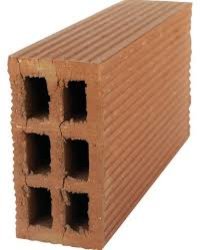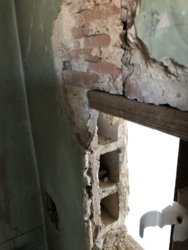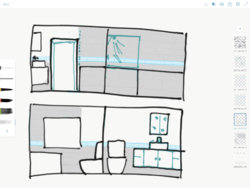Hello,
I’ll start by saying I’m not a pro. Im a DIYer but value doing things the right way.
I’m doing our bathroom, removing all the blown plaster and cleaning up the walls before using [insert appropriate tile backer board here], tanking the joints and tiling onto these.
I was going to use Hardiebacker 6mm boards, using gripfill adhesive, plus mechanical fixings, as shown on the hardiebacker install guides for masonry. However, the two internal walls are terracotta hollow tile block walls rather than brick. SEE HERE FOR EXACTLY WHAT I MEAN, it’s the only place I’ve found info on what the heck they are: Structural Terra Cotta - Structural Clay Tile - http://historicbldgs.com/terra_cotta.htm
They are one chamber thick (see diagram on that page), though the ribbed-for-your pleasure surface runs horizontally, rather than vertically shown in that picture.
I’m concerned that unless I go purely into the mortar joints with the fixings, I won’t get a proper fix onto the walls. Hardiebacker install video states the mech. fixings must go a minimum of 50mm into the masonry. Additionally, the uneven surface of the blocks makes me think the grab adhesive won’t get anywhere near enough contact with the blocks.
Does anyone have any experience with this situation, or could offer any advice please? Battening onto the wall is not an option as the bath would no longer fit between the end walls!!
I’ll start by saying I’m not a pro. Im a DIYer but value doing things the right way.
I’m doing our bathroom, removing all the blown plaster and cleaning up the walls before using [insert appropriate tile backer board here], tanking the joints and tiling onto these.
I was going to use Hardiebacker 6mm boards, using gripfill adhesive, plus mechanical fixings, as shown on the hardiebacker install guides for masonry. However, the two internal walls are terracotta hollow tile block walls rather than brick. SEE HERE FOR EXACTLY WHAT I MEAN, it’s the only place I’ve found info on what the heck they are: Structural Terra Cotta - Structural Clay Tile - http://historicbldgs.com/terra_cotta.htm
They are one chamber thick (see diagram on that page), though the ribbed-for-your pleasure surface runs horizontally, rather than vertically shown in that picture.
I’m concerned that unless I go purely into the mortar joints with the fixings, I won’t get a proper fix onto the walls. Hardiebacker install video states the mech. fixings must go a minimum of 50mm into the masonry. Additionally, the uneven surface of the blocks makes me think the grab adhesive won’t get anywhere near enough contact with the blocks.
Does anyone have any experience with this situation, or could offer any advice please? Battening onto the wall is not an option as the bath would no longer fit between the end walls!!



